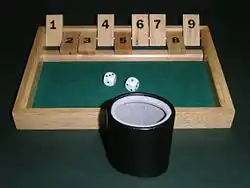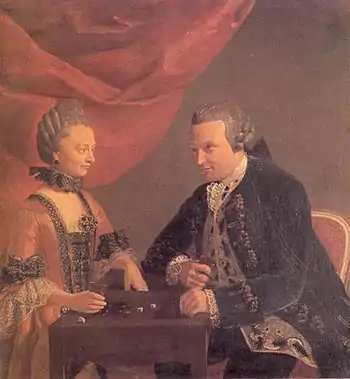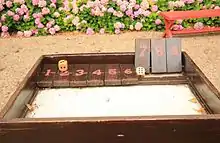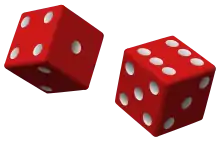Shut the box
Shut the box, also called Blitz, bakarat, Canoga, klackers, batten down the hatches, kingoball, trictrac, cut throat, fork your neighbor, and jackpot, is a game of dice for one or more players, commonly played in a group of two to four for stakes. Traditionally, a counting box is used with tiles numbered 1 to 9 where each can be covered with a hinged or sliding mechanism, though the game can be played with only a pair of dice, pen, and paper. Variations exist where the box has 10 or 12 tiles. Alternatively, dominoes can be used for the tiles - this also provides the option of using up to six dice if a Double 18 domino set is used. A deck of cards can also be used as tiles, and if so desired a complete conventional Western deck with the jokers (54 cards) can provide for the use of up to nine dice. As described below under Variants, the dominoes or cards can also be used in place of the dice if so desired.
 | |
| Genre(s) | Dice-rolling Solitaire |
|---|---|
| Players | 1 (Solitaire) or more |
| Setup time | 1 minute |
| Playing time | 2-3 minutes per player |
| Random chance | High (Dice rolling) |
| Skill(s) required | Risk management Arithmetic |
Rules
At the start of the game all levers or tiles are "open" (cleared, up), showing the numerals 1 to 9.
During the game, each player plays in turn. A player begins his or her turn by throwing or rolling the die or dice into the box. If the remaining tile(s) show 6 or lower, the player may roll only one die. Otherwise, the player must roll both dice.
After throwing, the player adds up (or subtracts) the pips (dots) on the dice and then "shuts" (closes, covers) one of any combination of open numbers that equals the total number of dots showing on the dice. For example, if the total number of dots is 8, the player may choose any of the following sets of numbers (as long as all of the numbers in the set are available to be covered):
- 8
- 7, 1
- 6, 2
- 5, 3
- 5, 2, 1
- 4, 3, 1
The player then rolls the dice again, aiming to shut more numbers. The player continues throwing the dice and shutting numbers until reaching a point at which, given the results produced by the dice, the player cannot shut any more numbers. At that point, the player scores the sum of the numbers that are still uncovered. For example, if the numbers 2, 3, and 5 are still open when the player throws a one, the player's score is 10 (2 + 3 + 5 = 10). Play then passes to the next player.
After every player has taken a turn, the player with the lowest score wins.
If a player succeeds in closing all of the numbers, he or she is said to have "Shut the Box" – the player wins immediately and the game is over.
Traditional pub play
In English pubs, Shut the Box is traditionally played as a gambling game. Each player deposits an agreed amount of money into a pool at the beginning of the game, and the winner of the game collects the money in pool at the end of the game and in some cases the box as well.
Variants

Shut the box is a traditional game, and there are many local and traditional variations in the rules. In addition, due to the game's growing popularity, many variations of the game have developed in recent years.
The three most popular variants are:
- Golf – A player's score is the sum of the numbers remaining uncovered at the end of his turn. The player with the lowest score wins.
- Missionary – A player's score is the total number (count) of the tiles remaining uncovered at the end of his turn. For example, a player scores 3 if at the end of his turn 3 tiles remain open. The player with the lowest score wins.
- Canoga - a gambling variant produced by the Pacific Game Company; the company also produced a 12-tile variant, Canoga XII. (Canoga can also be played using a regular game set using chips.)
- Chips are divided evenly among all players.
- Players decide on an ante to place in the kitty (a half-round pocket on the playing field).
- Players roll to see who goes first; play then rotates clockwise.
- Players play a traditional round, scoring as described in "Golf" above, resulting in a winner and loser(s).
- Each loser pays his difference in score to the winner. For example, if the lowest (winning) score is 11, and a losing score is 15, the loser pays 4 to the winner. The winner is paid by each loser.
- Bonus payout: if the winner "clears the board" (scores 0 or "shuts the box"), the payout is as above but doubled, and the winner takes the kitty.
- If there are tied winners, total payout is either split between or among the winners or multiplied for each winner, depending on how the players agree to do this before starting the game.
The following are examples of known variations in play, setup, and scoring:
- 2 to go – Standard game, numbers 1 to 9 up, on the first roll, the number 2 has to be dropped. If you roll 4 on your first roll, you lose.
- 3 down extreme – numbers 1, 2 and 3 are pre dropped, leaving numbers 4 to 9 up.
- 3 to go – The same as 2 to go but the number 3 must be dropped.
- Lucky number 7 – The only number up is 7, and the first person to roll a 7 wins.
- Unlucky number 7 – A standard game, when a 7 is rolled, the game stops.
- Against all odds – All odd numbers are up and evens down.
- Even Stevens – All even numbers are up and odds down.
- Full house – 12 numbers are up.
- The 300 – 2 boxes and 4 dice are used, with the second box representing numbers 13 – 24. (24+23+22...2+1 = 300); in the absence of a second box, cards or dominoes can be used to represent tiles 13 to 24. A Double 12 Dominoes set can also be used with four dice for this variant and other domino sets can be used by themselves to, in the case of the Double 18 set, provide for the use of six dice by themselves without the counting box.
- Domino Non-Dice Variants - A non-dice variant of the game can be played with the dominoes from either Western or Chinese sets ranging from 1 and 1 to 6 and 6 pips being used and most effectively put into a small bag for drawing, and the double blank being included along with blank and 1, with the former being either a free turn of sorts as it adds to zero or ending the turn, and the latter effectively ending the turn if the 1 tile has already been used.
- Card Non-Dice Variants - Another variant using cards dealt from one or more decks using the A, 2, 3, 4, 5, 6 or those cards along with the 7, 8, 9, 10, and two face cards agreed upon for the equivalent of dice rolls adding up to 11 and 12 pips.
- Thai style (Jackpot) – Always roll two dice, but only cover one tile matching one of the dice or their sum. For example, if the dice show a 2 and a 3 you may cover one of 2, 3, or 5.
- Digital – A player's score at the end of the turn is the number obtained by reading the up digits as a decimal number from left to right. For example, if 1, 2, and 5 are left up the score is 125. This is also known as "Say what you see", a reference to Roy Walker's catchphrase from the TV game show Catchphrase.
- 2012 – All 12 are up, but use a 20-sided die rather than the pair of 6 dice: 20-sided die playing 12 numbers.
It is also possible to play extended versions in which each game is a "round" of a longer game. Examples of such versions include:
- Tournament – Rounds are played with the Golf scoring method until a player reaches or exceeds a grand total of 100 points, at which time the player with the lowest point total is declared to be the winner.
- At the end of each round, each player's score for the round is added to his total score. When a player's score reaches 45, he must drop out of the game. The last player remaining wins the game.
- Simplified variant for younger players – Needs at least a 2 player box. During the game, each player plays in turn. After rolling both dice, the player adds up the dots on the dice and then shuts the tile for either the total number of dots, or one or both of the numbers on the dice. For example, if the player rolled a 6 and a 2, they may close either the 8 tile, or both the 6 tile and the 2 tile, or just the 6 tile, or just the 2 tile (as long as the numbers are available to be covered). The player then rolls the dice again, aiming to shut more numbers. The player continues throwing the dice and shutting numbers. The first one to shut all the tiles, wins.
History

Unconfirmed histories of the game suggest a variety of origins, including 12th century Normandy (northern France) as well as the mid 20th century Channel Islands (Jersey and Guernsey) thanks to a man known as Mr. 'Chalky' Towbridge.[1]
There is printed evidence of a dice game known as "shut the box" being played in Manchester pubs in the mid-1960s.[2]
Shut the Box is also the basis of the popular TV quiz show High Rollers, which ran from 1974 to 1976 and 1978 to 1980 on NBC with Alex Trebek as the host. The show resurfaced from 1987 to 1988, this time hosted by Wink Martindale.
Versions have also been played in Barotseland (Zambia, central Africa). The game is also popular in the beer bars of Thailand using special rules.
See also
References
- Timothy Finn writes in Pub Games of England that this happened in 1958.
- "'Shut the Box' at Wilson's New House". Brewing Review. 1967.
External links
- Shut the Box open source physics versions with options from Wikipedia
- Shut the Box – Online version. 9, 10, 11 and 12 tile versions.
- Shut the Slots – Online version. Variation based on spinning Slots for the tiles.
- Shut the Box – Online HTML5/Javascript version, rules and variants explained (accessible via application menu), MIT licensed.
- Shut the Box – Online PHP version, originally created as part of a Boy Scouts of America Programming merit badge project.
